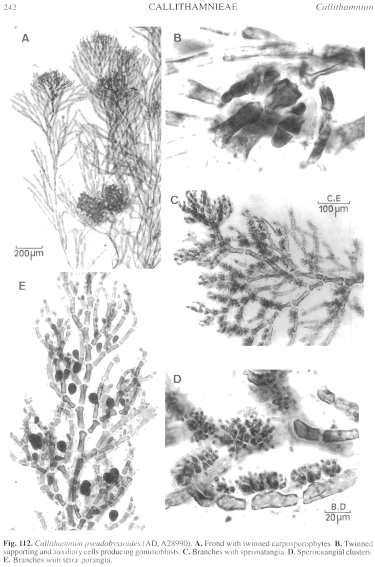|
|
|
|
|
|||||||||||
|
Electronic Flora of South Australia Species Fact Sheet
Phylum Rhodophyta – Order Ceramiales – Family Ceramiaceae – Tribe Callithamnieae
Synonyms
Aglaothamnion pseudobyssoides (Crouan & Crouan) Halos 1965: 117. L' Hardy–Halos & Rueness 1990: 357, figs 10,11,23–30. Maggs & Hommersand 1993: 107, fig. 36.
? Callithamnion debile Harvey 1855a: 563; 1863, synop.: lii. J. Agardh 1876: 44. Huisman & Walker 1990: 419. Lucas 1927: 469, pl. xxv fig. 1? Silva et al. 1996: 334.
Spongoclonium? debile (Harvey) De Toni 1903: 1364. Lucas 1909: 50. Sonder 1881: 10.
Thallus (Fig. 112A) erect, red-brown fading to grey, 5–15 mm high, densely tufted and much branched with several axes and laterals of several orders, radially branched, ecorticate throughout. Attachment by loose rhizoids; epilithic. Structure. Lower and mid axes 45–75 µm in diameter, cells L/D (3–) 4–8 (–10), lateral branchlets with lower cells 25–45 µm in diameter and L/D 2–4, tapering slightly to 20–30 µm in diameter and L/D (1–) 1.5–2 at 3–4 cells below apices, apical cells 10–14 µm in diameter and L/D 1–2, with rounded ends. Cells uninucleate; rhodoplasts discoid, ribbon like in larger cells.
Reproduction: Gametophytes dioecious. Procarps borne on mid cells of the branchlets, with two periaxial cells one of which (the supporting cell) bears the horizontal 4-celled carpogonial branch; post fertilization each periaxial cell cuts off an auxiliary (Fig. 112B) cell which develops rounded lobes (Fig. 112A) 150–250 µm across of ovoid carposporangia 15–25 µm across, with involucral branches from lower branch cells irregularly surrounding the carposporophyte. Spermatangial clusters (Fig. 112C, D) adaxial and profuse on cells of the branchlets, with a larger basal cell cutting off a spreading plate of cells which form initials bearing ovoid spermatangia 2–3 µm in diameter.
Tetrasporangia (Fig. 112E) sessile and adaxial on cells of the ultimate branchlets, ovoid, 35–55 µm in diameter, tetrahedrally divided.
Type from Kervallon, France (Crouan); lectotype in LD.
Selected specimens: South West R. mouth, Kangaroo I., S. Aust., rear of reef (Womersley, 17.i.1965: AD, A28990).
Distribution: Europe.
In southern Australia from South West R. mouth, Kangaroo I., S. Aust.
Taxonomic notes: The above collection agrees well with descriptions and illustrations of this European species (observed also by Dr Christine Maggs). It is possible that C. debile should be a synonym, though Harvey described C. debile as having upper distichous branching; however, this is not apparent in the type which appears to be irregularly radially branched throughout. Until fertile female specimens from Rottnest I. or nearby are available, C. debile cannot be confirmed as a synonym.
References:
AGARDH, J.G. (1876). Species Genera et Ordines Algarum. Vol. 3, Part 1- Epicrisis systematic Floridearum, pp. i-vii, 1–724. (Weigel: Leipzig.)
CROUAN, P.L. & CROUAN, H.M. (1867). Florule du Finistère. (F. Klincksieck: Paris.)
DE TONI, G.B. (1903). Sylloge Algarum omnium hucusque Cognitarum. Vol. 4. Florideae. Sect. 3, pp. 775–1521 + 1523–1525. (Padua.)
HALOS, M.T. (1965). Sur trois Callithamniées des environs de Roscoff. Cah. Biol. mar 6, 117–134.
HARVEY, W.H. (1855a). Some account of the marine botany of the colony of Western Australia. Trans. R. Jr. Acad. 22, 525–566.
HARVEY, W.H. (1863). Phycologia Australica. Vol. 5, Plates 241–300, synop., pp. i-lxxiii. (Reeve: London.)
HUISMAN, J.M. & WALKER, D.I. (1990). A catalogue of the marine plants of Rottnest Island, Western Australia, with notes on their distribution and biogeography. Kingia 1, 349–459.
LUCAS, A.H.S. (1909). Revised list of the Fucoideae and Florideae of Australia. Proc. Linn. Soc. N.S.W. 34, 9–60.
LUCAS, A.H.S. (1927). Notes on Australian marine algae. IV. The Australian species of the genus Spongoclonium. Proc. Linn. Soc. N.S.W. 52, 460–470, Plates 27–35.
MAGGS, C.A. & HOMMERSAND, M.H. (1993). Seaweeds of the British Isles. Vol. 1. Rhodophyta. Part 3A, Ceramiales. (HMSO: London.)
SILVA, P.C., BASSON, P.W. & MOE, R.L. (1996). Catalogue of the Benthic Marine Algae of the Indian Ocean. (University of California Press: Berkeley, Los Angeles & London.)
SONDER, O.W. (1881). In Mueller, F., Fragmenta Phytographiae Australiae. Supplementum ad volumen undecinum: Algae Australianae hactenus cognitae, pp. 1–42, 105–107. (Melbourne.)
The Marine Benthic Flora of Southern Australia Part IIIC complete list of references.
Publication:
Womersley, H.B.S. (24 December, 1998)
The Marine Benthic Flora of Southern Australia
Rhodophyta. Part IIIC. Ceramiales – Ceramiaceae, Dasyaceae
©State Herbarium of South Australia, Government of South Australia
Illustration in Womersley Part IIIA, 1998: FIG. 112.

Figure 112 enlarge
Fig. 112. Callithamnion pseudobyssoides (AD, A28990). A. Frond with twinned carposporophytes. B. Twinned supporting and auxiliary cells producing gonimoblasts. C. Branches with spermatangia. D. Spermatangial clusters. E. Branches with tetrasporangia.

|
Email Contact: State Herbarium of South Australia |

|